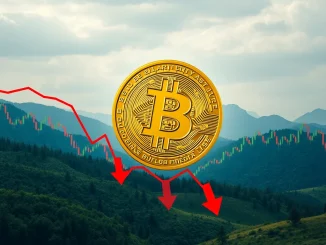
The pulse of the cryptocurrency market often feels like a rollercoaster, swinging wildly between euphoria and despair. How do we measure this collective mood? Enter the Crypto Fear and Greed Index, a popular tool that provides a snapshot of current crypto market sentiment. Recently, this key indicator saw a notable jump, moving firmly into ‘Greed’ territory.
Understanding the Crypto Fear and Greed Index
Provided by software development platform Alternative, the Crypto Fear and Greed Index aggregates various data points to assign a single number between 0 (Extreme Fear) and 100 (Extreme Greed). A low number suggests investors are overly fearful, potentially signaling a buying opportunity. A high number indicates excessive greed, which could precede a market correction.
As of April 29, the index registered a reading of 60. This is a significant increase of six points from the previous day’s neutral stance, pushing the market’s emotional temperature into the ‘Greed’ zone.
What Drives the Index? Key Factors
The index isn’t just a random number; it’s calculated based on a weighted average of six different factors, aiming to provide a comprehensive view of market sentiment crypto:
- Volatility (25%): Measures current volatility and maximum drawdown compared to average values. Higher volatility in a positive direction often increases the index.
- Market Momentum/Volume (25%): Analyzes current volume and market momentum, comparing them with average values. High buying volume usually points to greedy or bullish behavior.
- Social Media (15%): Scans social media platforms for sentiment analysis on specific cryptocurrencies, particularly focusing on engagement and positive/negative mentions.
- Surveys (15%): While currently paused by the provider, this factor historically involved weekly sentiment surveys to gauge retail investor feeling.
- Bitcoin Dominance (10%): Measures Bitcoin’s share of the total crypto market cap. Rising dominance can indicate fear (investors moving to BTC as a safe haven) or greed (strong BTC rallies leading the market). Its interpretation depends on the context.
- Google Trends (10%): Analyzes search query trends for terms related to cryptocurrencies, looking for increases in searches like ‘Bitcoin price manipulation’ (fear) or ‘buy crypto’ (greed).
Decoding the Shift: From Neutral to Greed
Moving from ‘Neutral’ (typically 40-59) to ‘Greed’ (60-79) signifies a noticeable improvement in overall crypto market sentiment. This suggests that investors are becoming more confident, perhaps even exuberant. Prices are likely rising, and there’s increased positive chatter and trading activity.
For those tracking Bitcoin sentiment specifically, this index reading is particularly relevant, given Bitcoin’s significant influence on the overall market and its weighting within the index calculation (via dominance and likely heavily influencing volatility, volume, and trends).
What Does a High Crypto Greed Index Mean for You?
Historically, periods of extreme greed (index values above 80) have often preceded market pullbacks. The saying goes: “Be fearful when others are greedy, and greedy when others are fearful.” While 60 isn’t ‘Extreme Greed’, it indicates caution might be warranted, especially if the index continues to climb rapidly.
It’s important to remember that the crypto greed index is just one tool. It doesn’t predict the future with certainty but offers insight into the prevailing emotional state of the market. Traders often use it as a counter-indicator – a high reading might signal a potential time to take profits or be cautious about new entries, while a low reading might suggest potential buying opportunities.
Conclusion: Navigating Greed in the Crypto Market
The rise of the Crypto Fear and Greed Index to 60 and its entry into the ‘Greed’ zone reflects a positive shift in market sentiment crypto. This increased confidence is fueled by various factors measured by the index. While it’s encouraging to see optimism return, smart participants understand that excessive greed can be a warning sign. Keep this index on your radar, but always combine it with other analysis tools and strategies when making decisions in the dynamic crypto space.



